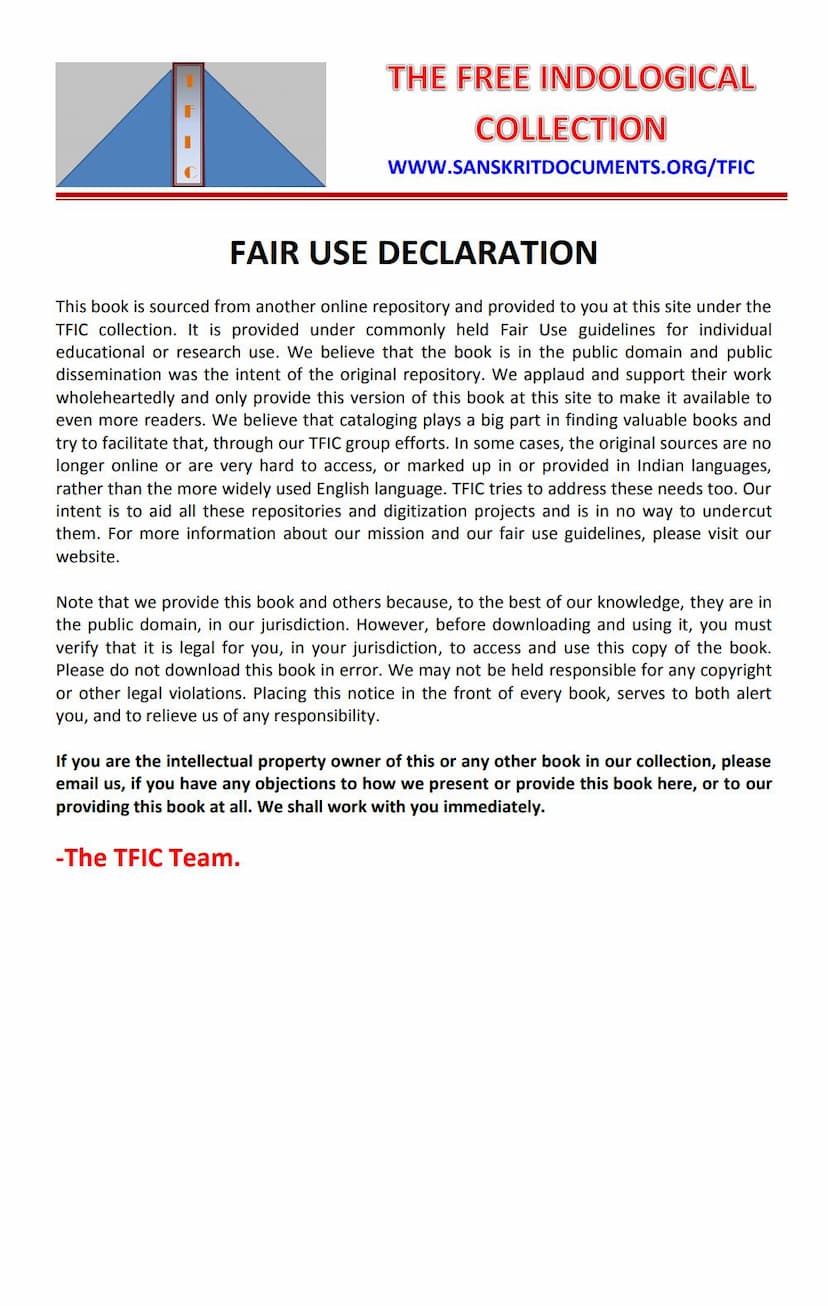Upnidana Sutram
Added to library: September 2, 2025
Loading image...

Summary
This document provides a critical edition of the Upanidāna-sūtra, also known as Sāmagānāṁ Chandah (Metres of the Sāmagānas), edited by Mangaldev Shastri and published in 1931.
Here's a comprehensive summary based on the provided pages:
1. Introduction and Manuscript Basis:
- Discovery and Editorial Challenge: Mangaldev Shastri first encountered the Upanidāna-sūtra in a manuscript (designated B¹) in the Government Sanskrit Library, Benares, in 1930. He recognized its importance for Vedic and especially Sāma-veda metres. The initial challenge was the lack of other available manuscripts, making a critical edition difficult.
- Confirmation through Commentary: A breakthrough occurred when he read a commentary on the Yajur-sarvānukramaṇi by Deva Yājnika. He found numerous ślokas on metre quoted from a work called Chandogapariṣṭa, which he identified as his Upanidāna-sūtra.
- Finding More Manuscripts: This discovery led to a re-examination of library catalogues, revealing the work under various names like "Chandaḥ," "Chandaḥ-vichaya," and "Sāmagānāṁ Chandah." A subsequent patient search in the Benares library unearthed a second manuscript (B²) of the work titled "Chandaḥ," which was found to be identical with the Upanidāna-sūtra.
- Manuscript Details:
- B¹: Dated Samvat 1675 (1618 CE), 8 folios, approximately 10 lines/page, 31 letters/line. It ends with a colophon mentioning the scribe and date.
- B²: Dated Samvat 1714 (1657 CE), 7 folios, approximately 10 lines/page, 25 letters/line. It also has a colophon. B² shows some attempts at dividing the text with strokes, which the editor found arbitrary in many cases.
- Collated Manuscript (L): A photo-copy of a manuscript from Lahore was also collated for a few folios.
- Editorial Method:
- The division of sūtras in this edition is based on the editor's judgment, informed by comparative study of works like the Ṛgveda prātiśākhya, Pingala-sūtra, and Yajuh-sarvānukramaṇi. The editor acknowledges the possibility of errors in this division and therefore refrains from numbering the sūtras.
- Instead of just numbers, colophons like "iti Adhyāyaḥ" (end of chapter) have been added at the end of each of the eight chapters. The term "Adhyāya" for these chapters is the editor's own.
- The last four stanzas of chapter VIII, identified as an appendix, were excluded from the chapter itself based on manuscript evidence (B¹).
- References for Vedic quotations and parallel passages in other works are provided in footnotes.
2. Name and Nature of the Work:
- Multiple Names: The work is known by various names in different manuscript catalogues, including:
- Chandaḥ vichaya
- Sāmagānāṁ Chandah
- Upanidānam
- Chandogapariṣṭa (as mentioned in Deva Yājnika's commentary)
- Chosen Name: Upanidāna-sūtra: The editor chose this name because:
- It is more significant, indicating its connection to the Sāma-veda.
- It suggests dependence on the Nidāna-sūtra (as confirmed by a concluding stanza).
- Manuscript B¹, the oldest dated manuscript, calls it "Upanidāna."
- Although B¹ calls it "Upanidāna," the editor named it "Upanidāna-sūtra" as it is written in the sutra style.
- Nature: It is an "Anukramaṇī" literature similar to those for other Vedas, aiming to catalog the metres of the Sāma-veda-samhitā. It also provides a general outline of Vedic metres in the first three chapters and a concluding chapter of a general nature.
3. Contents and Scope of the Work:
- Chapter I: General discussion of metres, defining the seven Ārsa metres (Gāyatrī, Uṣṇik, Anuṣṭubh, Bṛhatī, Paṅkti, Triṣṭubh, Jagatī), their varieties, and names for different parts of metres (like pāda-viśeṣa).
- Chapter II: Deals with defective (nyūna) and atichandas (excessive) metres, and the method for determining the nature of doubtful metres.
- Chapter III: Focuses on Daiva, Āsura, and Prājāpatya metres, as well as those of Yajuh, Sāman, and Ṛc.
- Chapters IV-VII: Form the core, detailing the metres of the Sāma-veda-samhitā:
- Chapters IV & V: Anukramaṇī of the metres in the Purvārcika.
- Chapter VI: Anukramaṇī of the metres in the Āraṇyakāṇḍa and Mahānāmnyārcika.
- Chapter VII: Deals with the metres of the Uttarārcika, focusing on exceptional cases and irregular metres (vikāra).
- Chapter VIII: Discusses the colours (varṇa) and deities (devatā) of the various metres. This is followed by four concluding stanzas about the sources and praise of prosody.
4. Date and Authorship:
- Antiquity: The work is considered ancient due to its nature, sutra style, and the tone of its concluding and initial sūtras.
- Lack of Early References: Despite its antiquity, it is noted that the work is not frequently referenced by very old authors, nor by Sāyaṇa, even though Sāyaṇa does mention metres in his commentary.
- Deva Yājnika's Reference: The work is extensively cited in Deva Yājnika's commentary on the Yajuh-sarvānukramaṇi. Deva Yājnika is known to have lived after Sāyaṇa and quoted Madhvācārya (identified with Sāyaṇa).
- Dating Deva Yājnika: A manuscript of Deva Yājnika's commentary, acquired from the Jalīdāsa collection and transcribed in Samvat 1619 (1562 CE), suggests Deva Yājnika lived at least 50 years before that, placing him before Sāyaṇa. This raises the question of why Sāyaṇa didn't refer to the Upanidāna-sūtra.
- Authorship Uncertainty: The authorship is unknown. The concluding phrase "ityāha Bhagavan Gārgyo Gārgyaḥ" might refer to the entire work, suggesting Gargya or someone from the Gargya school as the author. However, this is unlikely if the work draws from Pingala, who is later than Yaska. The editor also plans to investigate which Śākhā of the Sāma-veda the Upanidāna-sūtra belongs to, as this might explain Sāyaṇa's silence.
5. Acknowledgements:
- The editor expresses gratitude to the editor of the Princess of Wales Sarasvati-Bhavana Texts for including the work and to Pandita Nārāyaṇa Sastri Khiste for his cooperation in manuscript searches.
In essence, the Upanidāna-sūtra is a critical work on the metres of the Sāma-veda, providing a systematic catalog and analysis of these metres. Its historical context, manuscript traditions, and scholarly study are highlighted in this introduction to the 1931 edition.